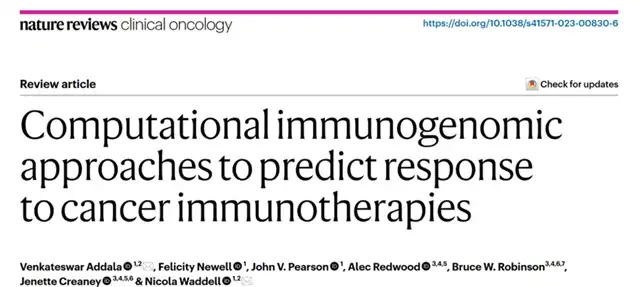How to determine which immunotherapy a cancer patient needs?
- Normal Liver Cells Found to Promote Cancer Metastasis to the Liver
- Nearly 80% Complete Remission: Breakthrough in ADC Anti-Tumor Treatment
- Vaccination Against Common Diseases May Prevent Dementia!
- New Alzheimer’s Disease (AD) Diagnosis and Staging Criteria
- Breakthrough in Alzheimer’s Disease: New Nasal Spray Halts Cognitive Decline by Targeting Toxic Protein
- Can the Tap Water at the Paris Olympics be Drunk Directly?
How to determine which immunotherapy a cancer patient needs?
- Should China be held legally responsible for the US’s $18 trillion COVID losses?
- CT Radiation Exposure Linked to Blood Cancer in Children and Adolescents
- FDA has mandated a top-level black box warning for all marketed CAR-T therapies
- Can people with high blood pressure eat peanuts?
- What is the difference between dopamine and dobutamine?
- How long can the patient live after heart stent surgery?
How to determine which immunotherapy a cancer patient needs?
Since the elucidation of DNA’s structure in 1953, scientists worldwide have attributed all questions seeking explanation to changes in the structure of certain DNA, RNA, or protein molecules within cells. When it comes to tumors, the prevailing belief has been that if cells transform into cancerous cells, it is due to a mutation in a key DNA, RNA, or protein molecule.
But is this really the case? After years of extensive research, the answer is a nuanced one. With substantial funding and the support of high-throughput omics sequencing, researchers have indeed discovered numerous molecular abnormalities within tumor cells. However, describing these changes as a rebellion is far from accurate; some changes are subtle, others significant, and some alterations affect the social dynamics within cells, occurring at unexpected times and places.
An article published in Nature Review in January declared a somewhat despairing fact: doctors are now struggling to determine which immunotherapy method is best suited for individual cancer patients. The era has arrived where artificial intelligence must integrate data from tumors, the microenvironment, and immune cells to purposefully select treatment methods, marking a transition from “big data” to a magnificent era of “data largesse.”

01. Data Mining: Tumor Cell Level
1.1 Intratumor Heterogeneity (ITH)
Analyzing characteristics related to tumor cells involves exploring purity, gene mutations, and novel cancer antigens. Tools like PyClone, SciClone, Battenberg, HATCHet, and FastClone support these analyses.
1.2 Tumor Mutational Burden (TMB)
Understanding the personality of cells involves detecting gene mutations (TMB). Tools ranging from classic single-nucleotide mutations to advanced techniques like ultra-deep sequencing and tissue-specific expression analysis contribute to TMB analysis.
1.3 Exploration of Neoantigens
To depict the specific features of suspicious tumor cells, databases like ClinicalTrials.gov accumulate data on non-classical characteristics such as gene fusions, chromosomal structural variations, transposons, mRNA splicing anomalies, and even proteins resembling cancer features secreted by gut microbiota.
02. Data Mining: Tumor Microenvironment Level
While the previous analyses focus on tumor-related features, understanding the tumor microenvironment (TME) is crucial. This includes interactions between tumor cells, stromal cells, and immune cells through shared factors like cytokines, chemokines, adhesion molecules, and growth factors.
Scientists are particularly interested in activating T lymphocytes in the TME, as it determines the effectiveness of cancer immunotherapy. Classic transcriptome sequencing and DNA methylation sequencing, along with tools like CIBERSORT, TIMERTool, ImSig, EPIC, xCell, MCP-counter, scPred, CellAssign, SCCF, MARS, SCENIC, Monocle, and single-cell transcriptome sequencing, play pivotal roles in understanding TME complexities.
03. AI Analysis: Transitioning from “Big Data” to “Data Largesse”
Combining multiple omics data, artificial intelligence aims to construct and train machine learning models using various data categories. This approach seeks to identify key parameters quickly and predict whether a specific cancer treatment will be effective for a given patient.
For example, immune checkpoint inhibitor (ICI) therapy, a prominent cancer treatment, exhibits variable effectiveness among patients. Researchers employ machine learning models to predict ICI treatment outcomes based on whole exome sequencing, integrating multiple genomic features.
As part of human destiny and history, cancer has undergone transformations paralleling shifts in Eastern and Western philosophies. The integration of artificial intelligence with multi-omics data analysis represents a crucial step toward comprehensively understanding and eventually curing cancer.
How to determine which immunotherapy a cancer patient needs?
References:
[1] Addala V, Newell F, Pearson JV, Redwood A, Robinson BW, Creaney J, Waddell N. Computational immunogenomic approaches to predict response to cancer immunotherapies. Nat Rev Clin Oncol. 2024 Jan;21(1):28-46. doi: 10.1038/s41571-023-00830-6. Epub 2023 Oct 31. PMID: 37907723.
[2] Richard, C. et al. Exome analysis reveals genomic markers associated with better efficacy of nivolumab in lung cancer patients. Clin. Cancer Res. 25, 957–966 (2019).
[3] Bareche, Y. et al. Leveraging big data of immune checkpoint blockade response identifies novel potential targets. Ann. Oncol. 33, 1304–1317 (2022).
[4] Litchfield, K. et al. Meta-analysis of tumor- and T cell-intrinsic mechanisms of sensitization to checkpoint inhibition. Cell 184, 596–614.e14 (2021).
(source:internet, reference only)
Disclaimer of medicaltrend.org
Important Note: The information provided is for informational purposes only and should not be considered as medical advice.



